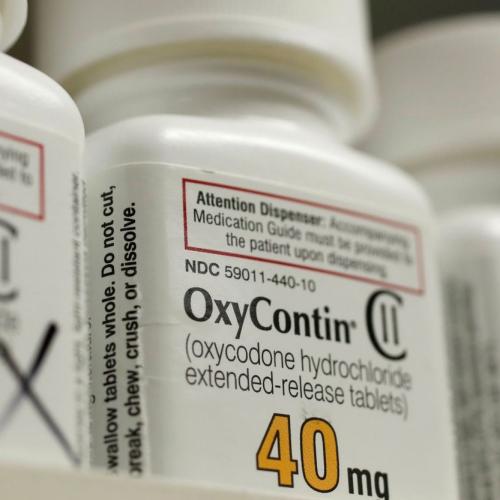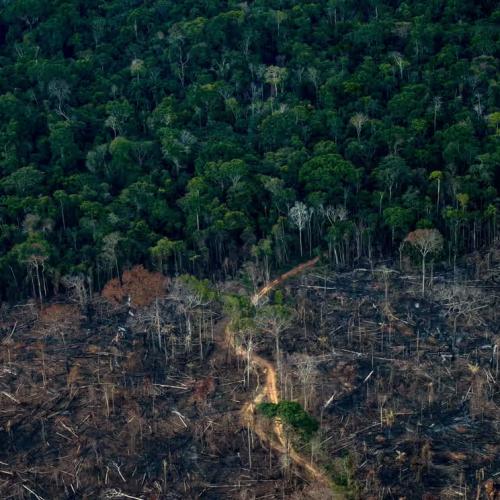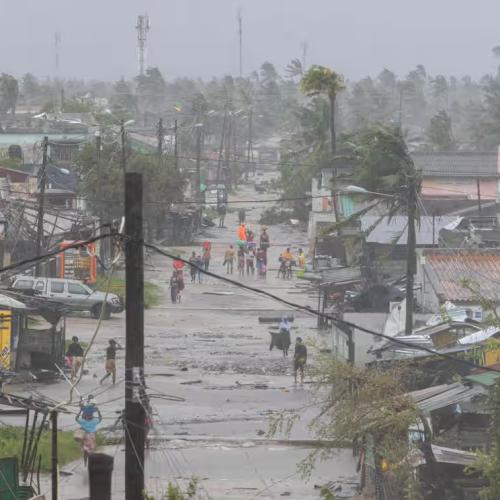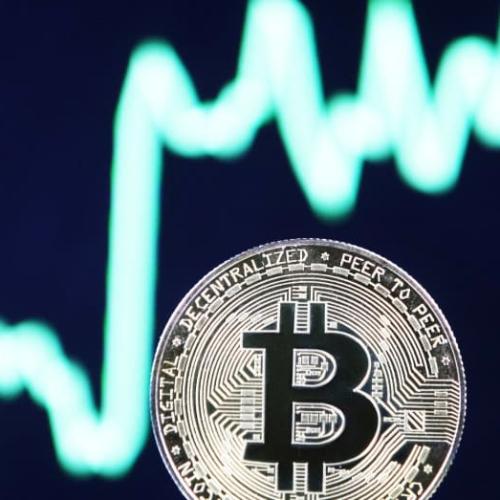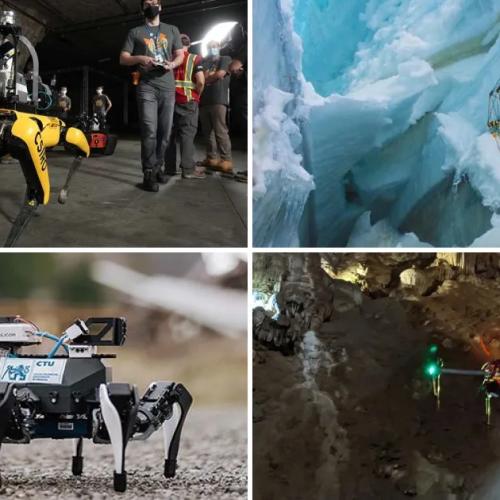Global Warming News Stories
Below are key excerpts of revealing news articles on global warming from reliable news media sources. If any link fails to function, a paywall blocks full access, or the article is no longer available, try these digital tools.
In the past few years, the number of rocket launches has spiked as commercial companies — especially SpaceX, founded by Elon Musk — and government agencies have lofted thousands of satellites into low-Earth orbit. And it is only the beginning. Satellites could eventually total one million, requiring an even greater number of space launches that could yield escalating levels of emissions. Scientists worry that more launches will scatter more pollutants in pristine layers of Earth’s atmosphere. And regulators across the globe, who assess some risks of space launches, do not set rules related to pollution. Experts say they do not want to limit the booming space economy. But they fear that ... we may understand the consequences of pollution from rockets and spacecraft only when it is too late. Already, studies show that the higher reaches of the atmosphere are laced with metals from spacecraft that disintegrate as they fall back to Earth. In a paper published in 2022, soot from rockets was shown to be nearly 500 times as efficient at heating the atmosphere as soot released from sources like airplanes closer to the surface. A separate study also published in 2022 found that if the rate of rocket launches increased by a factor of 10, their emissions could cause temperatures in parts of the stratosphere to rise as much as 2 degrees Celsius. This could begin to degrade the ozone over most of North America, all of Europe and a chunk of Asia.
Note: The risks posed by satellites expand beyond emissions. For more along these lines, see concise summaries of deeply revealing news articles on climate change from reliable major media sources.
The solution to stopping climate change might be buried on 10 acres in the Pauma Valley of California. “The idea is not just to produce food but to improve the soil,” says Alvarez, Solidarity Farm’s Climate Resilience Specialist. “We stopped using the plow to turn the soil, and we do a lot of composting and mulching to improve our soil health.” Solidarity Farm had used organic principles in the 10 years since its inception, but it pivoted to carbon farming after the extreme heat in the summer of 2017. Carbon farmers cultivate plants and trees in a way that maximizes carbon sequestration in the soil. Among the most important practices for carbon farmers are minimizing soil erosion by planting perennials and ground cover, which also lowers soil temperatures, and only working the land by hand or with low-tech solutions. “The soil has the capacity to store more carbon than all plants on the planet together,” Alvarez says. Solidarity Farms produces a diverse range of about 60 different fruits and vegetables, at least 70 percent of them perennial crops such as plums and pomegranates. Stacks of organic chicken manure in front of the vegetable beds wait to be distributed. The farmers enrich the soil with compost and mulch, while deterring pests with diverse crop rotation. According to soil tests, the Solidarity farmers have tripled the amount of carbon in the ground since 2018. “This equates to a drawdown of nearly 600 metric tons of CO2 per year, offsetting the emissions of 80 American households,” Alvarez says.
Note: Have you seen the groundbreaking and inspiring movie Kiss the Ground? In a time where we're told hopeless and divisive narratives about our current environmental challenges, people all over the world are reversing the damage from destroyed ecosystems, regenerating the world's soils, and creating abundant food supplies. Don't miss this powerful film on the growing regenerative agriculture movement and its power to revive global community and our connection to the natural world.
When Anthony Myint and his wife Karen Leibowitz opened their San Francisco restaurant The Perennial in 2016, they had big ambitions: They wanted it to be the first carbon-neutral restaurant in the world, and they succeeded. From the recycled floor tiles and reclaimed lumber to the aquaponic herb garden and compostable paper menus, the culinary duo designed every part of the diner with the climate in mind. “We shifted the menus, reduced food waste, switched to renewable energy, started composting and bought carbon offsets,” Myint says. They were motivated by the knowledge that agriculture and food systems contribute nearly a third of greenhouse gas emissions worldwide. The Perennial’s menu championed sourdough loaves baked with perennial Kernza grains, and the chefs bought their steaks from regenerative ranches associated with the Marin Carbon Project, the country’s foremost center for regenerative farming. The more Myint learned about regenerative agriculture, the more he became convinced that this was the global solution he needed to champion. “It became clear to me that this is the future of food, similar to the way renewable energy is the future of energy,” he says. “The whole food system needs to gradually transition.” Zero Foodprint is asking restaurant customers and other participating businesses to give one percent of their sales to a pool that funds regenerative agriculture. More than 80 businesses have signed up.
Note: We've summarized a handful of stories about the power of regenerative agriculture practices to reverse and heal global ecological destruction. Explore more positive stories like this in our comprehensive inspiring news articles archive focused on solutions and bridging divides.
Carbon credit speculators could lose billions as scientific evidence shows many offsets they have bought have no environmental worth and have become stranded assets. Amid growing evidence that huge numbers of carbon credits do nothing to mitigate global heating and can sometimes be linked to alleged human rights concerns, there is a growing pile of carbon credits ... that are unused in the unregulated voluntary market, according to market analysis. Many of the largest companies in the world have used carbon credits for their sustainability efforts from the unregulated voluntary market, which grew to $2bn (£1.6bn) in size in 2021 and saw prices for many carbon credits rise above $20 per offset. The credits are often generated on the basis they are contributing to climate change mitigation such as stopping tropical deforestation, tree planting and creating renewable energy projects. A new study in the journal Science has found that millions of forest carbon credits approved by Verra, the world’s leading certifier, are largely worthless and could make global heating worse if used for offsetting. The analysis ... found that 18 big forest offsetting projects had produced millions of carbon credits based on calculations that greatly inflated their conservation impact. The schemes, which generate credits by avoiding hypothetical deforestation, were found not to reduce forest loss or to reduce it by only small amounts, far less than the huge areas they were claiming to protect, rendering the credits largely hot air.
Note: For more along these lines, see concise summaries of deeply revealing news articles on financial industry corruption and climate change from reliable major media sources.
A number of Indigenous communities in the Amazon say that “carbon pirates” have become a threat to their way of life as western companies seek to secure deals in their territories for offsetting projects. Across the world’s largest rainforest, Indigenous leaders say they are being approached by carbon offsetting firms promising significant financial benefits from the sale of carbon credits if they establish new projects on their lands, as the $2bn (£1.6bn) market booms with net zero commitments from companies in Europe and North America. Proponents of carbon markets, especially those that aim to protect rainforests, say that carbon credits are a good way to fund the new areas and pay Indigenous communities for the stewardship of their lands. The resulting credits could then be used for climate commitments by western companies. Indigenous communities are being taken advantage of in the unregulated sector, with opaque deals for carbon rights that can last up to a century, lengthy contracts written in English, and communities being pushed out of their lands for projects. Examples include Peru’s largest ever carbon deal involving an unnamed extractive firm, where the Kichwa community claim they have been forced from their land in Cordillera Azul national park and received nothing from the $87m agreement. Several Indigenous communities spoke of training themselves in carbon market regulation and organising global exchanges to help others avoid falling victim to “carbon pirates”.
Note: An excellent investigation reveals that over 90% of rainforest offsets are likely to be “phantom credits” and do not represent real carbon reductions, yet are being used by Disney, Shell, Gucci, Salesforce, the band Pearl Jam, and other large corporations. For more along these lines, see concise summaries of deeply revealing news articles on climate change from reliable major media sources.
The White House has set into motion a five-year outline for research into “climate interventions”. Those include methods such as sending a phalanx of planes to spray reflective particles into the upper reaches of the atmosphere, in order to block incoming sunlight from adding to rising temperatures. Previous attempts at running experiments for what is known as solar radiation management (SRM) have faced staunch opposition. Last year, an exploratory flight in Sweden of a high-altitude SRM balloon, led by Harvard University researchers, was halted after objections by environmentalists and Indigenous leaders. This prospect horrifies opponents of solar geoengineering. An open letter signed by more than 380 scientists demands a global non-use agreement for SRM; it also says that growing calls for research in this area are a “cause for alarm”, due to an unknown set of ramifications that will have varying consequences in different parts of the world and could scramble “weather patterns, agriculture and the provision of basic needs of food and water”. Frank Biermann, an expert in global governance ... said he’s also disturbed that solar geoengineering will create a sort of moral hazard where governments ease off efforts to cut emissions and fossil fuel companies use it as cover to continue business as usual. There isn’t any international governance around solar geoengineering. Unilateral action to alter the climate could spark conflict if one part of the world benefits, while another suffers.
Note: There is much controversy around geoengineering, yet there is considerable evidence that reveals the possibility of its many applications. For more along these lines, explore revealing media articles on geoengineering and HAARP (High Frequency Active Auroral Research Program), a little-known U.S. military defense project that conducted investigations into weather control technologies, among many other concerning explorations.
Global capitalism is an incredible machine for extracting fossil fuels from our planet, refining them, shipping them to every corner of the Earth and making staggering amounts of money doing so. Unfortunately the machine is also poisoning us all. But one of its exquisitely evolved functions is to make it almost impossible to turn it off. Oil and gas profits in the most recent quarter were astounding. Exxon Mobil made $18bn in profits in the past three months. Shell and Chevron each made nearly $12bn. Those are all record numbers. A recent study showed that for the past 50 years, the oil industry has made profits of more than $1tn a year, close to $3bn a day. These profits are driven [by] cartels, mega-corporations and the regulatory capture of governments, conspiring to create a market free of both competition and of a price that reflects the actual cost to the world of the product that is being sold. These profits are illusory. They are plagued by an externality large enough to outweigh a trillion dollars a year – the costs that the climate crisis will impose on billions of people who are alive now and many generations to come. The fossil fuel industry as a whole is not just another business, providing a service to meet a demand; it is a predatory drug dealer that works every day to keep the world addicted to its poisonous product, knowing full well that it will eventually prove fatal. It fights to keep the population fooled. It is a problem to be solved.
Note: For more along these lines, see concise summaries of deeply revealing news articles on corporate corruption and climate change from reliable major media sources.
China has reduced air pollution nearly as much in seven years as the US did in three decades, helping to bring down average global smog levels in the process. The amount of harmful particulates in the air in China fell 40% from 2013 to 2020, according to the University of Chicago’s Energy Policy Institute, which would add about two years to average life expectancy if sustained. While smog in large swathes of the country still significantly exceeds safe levels, its experience shows how quickly progress can be made, researchers including Professor Michael Greenstone said in a report. About 97% of the world’s population live in areas where air quality is usually worse than World Health Organization guidelines, according to the researchers. Smog reduces global life expectancy more than cigarette smoking, alcohol or poor sanitation. “China’s success in reducing pollution is a strong indication of the opportunities that could lie ahead for other nations if they were to impose strong pollution policies,” they said. Even in the US and Europe ... more than 90% of people live in areas that don’t meet WHO guidelines, which were tightened last year. China’s success, led by restrictions on car use and coal burning in major cities, has been rapid, with its 40% decline in seven years nearly equaling a 44% drop in US pollution over 30 years from 1970, after the landmark Clean Air Act was passed. Without China’s declines, the world would have seen average pollution levels increase since 2013 instead of drop.
Note: Explore a treasure trove of concise summaries of incredibly inspiring news articles which will inspire you to make a difference.
The U.N. climate report released Monday presents a major leap forward in predicting how geoengineering to limit global warming might affect the planet, although scientists said the greatest hurdle remains deciding whether to use the controversial methods. Geoengineering involves large-scale interventions that shift the climate, generally with an aim of cooling the earth. The United Nations panel addressed two types of geoengineering in the report - solar radiation management and greenhouse gas removal. Solar radiation management techniques generally control how much sunlight is reflected back out into space. For example, humans could spray sulfate aerosols - tiny reflective particles - into the stratosphere ... to reflect more sunlight back into space, which lowers global temperatures. But sulfate aerosols have the side effect of also lowering average precipitation. While some regions could gain in an artificially cooler world, others could suffer by, for example, no longer having conditions to grow crops.
Note: Chemtrails anyone? Explore evidence that Spain is spraying chemtrails as part of a secret UN program. For more along these lines, see concise summaries of deeply revealing news articles on climate change from reliable major media sources.
In September 2019, Ryanair circulated a series of adverts on TV, radio and online which urged customers to fly with "Europe's Lowest Fares, Lowest Emissions Airline. Everybody knows that when you fly Ryanair you enjoy the lowest fares. But do you know you are travelling on the airline with Europe’s lowest emissions as well?" The Advertising Standards Agency (ASA), the UK's advertising watchdog, banned the campaign several months later after concluding that these claims were misleading. Ryanair is far from the only company to come under fire for making misleading climate claims. Since the Paris Agreement was signed in 2015, there has been a wave of corporate commitments to reduce emissions. But the increase in enthusiasm for climate responsibility has been matched by a rise in concerns that some companies are using advertising and public messaging, with buzzwords such as "carbon neutrality" and "net zero", to try to appear more sustainable than they actually are. This is referred to by some as "greenwashing". Consumers are increasingly seeing through misleading claims and making more complaints about them as a result. Almost 50 complaints are currently pending globally before a court or an advertising standards body, according to a recent report. The ASA plans to release new guidance to ensure adverts don't mislead the public about the environment in 2022. To date, most complaints regarding misleading climate claims are dealt with by watchdogs, rather than taken to court.
Note: For more along these lines, see concise summaries of deeply revealing news articles on corporate corruption and climate change from reliable major media sources.
The world is spending at least $1.8tn (£1.3tn) every year on subsidies driving the annihilation of wildlife and a rise in global heating, according to a new study, prompting warnings that humanity is financing its own extinction. From tax breaks for beef production in the Amazon to financial support for unsustainable groundwater pumping in the Middle East, billions of pounds of government spending and other subsidies are harming the environment, says the first cross-sector assessment for more than a decade. This government support, equivalent to 2% of global GDP, is directly working against the goals of the Paris agreement and draft targets on reversing biodiversity loss, the research on explicit subsidies found, effectively financing water pollution, land subsidence and deforestation with state money. The fossil fuel industry ($620bn), the agricultural sector ($520bn), water ($320bn) and forestry ($155bn) account for the majority of the $1.8tn, according to the report. No estimate for mining, believed to cause billions of dollars of damage to ecosystems every year, could be derived. Lack of transparency between governments and recipients means the true figure is likely to be much higher, as is the implicit cost of harmful subsidies. Last year, an International Monetary Fund report found the fossil fuel industry benefited from subsidies worth $5.9tn in 2020.
Note: For more along these lines, see concise summaries of deeply revealing news articles on government corruption and climate change from reliable major media sources.
The chairman of a House subcommittee is demanding that executives of Exxon Mobil Corp., Shell, Chevron and other major oil and gas companies testify before Congress about the industry's decades-long effort to wage disinformation campaigns around climate change. Representative Ro Khanna, Democrat of California, said Friday he was prepared to use subpoena power to compel the companies to appear before lawmakers if they don't do so voluntarily. The move comes a day after a secretive video recording was made public in which a senior Exxon lobbyist said the energy giant had fought climate science through "shadow groups" and had targeted influential senators in an effort to weaken President Biden's climate agenda. "The video was appalling," Mr. Khanna said in an interview on Friday. He called it the latest evidence of the fossil fuel industry's efforts to "engage in climate denialism and to manipulate public opinion and to exert undue influence in shaping policy in Congress." Mr. Khanna said the House Oversight and Reform Subcommittee on the Environment, which he chairs, will issue letters next week to top executives at Exxon Mobil, Shell, Chevron and other oil and gas companies and trade groups demanding documents and testimony. One major target of the panel's inquiry are dark money groups that have been funded by fossil fuel companies to disseminate falsehoods about climate science and policy solutions. The hearing is expected to be held in the fall.
Note: Learn more in this Washington Post article. For more along these lines, see concise summaries of deeply revealing news articles on corporate corruption and climate change from reliable major media sources.
Bill Gates has never been a farmer. So why did the Land Report dub him “Farmer Bill” this year? Gates’ achievement, according to the report, is that he’s largest private owner of farmland in the US. A 2018 purchase of 14,500 acres of prime eastern Washington farmland – which is traditional Yakama territory – for $171m helped him get that title. In total, Gates owns approximately 242,000 acres of farmland with assets totaling more than $690m. To put that into perspective, that’s nearly the size of Hong Kong and twice the acreage of the Lower Brule Sioux Tribe, where I’m an enrolled member. A white man owns more farmland than my entire Native nation! The relationship to land – who owns it, who works it and who cares for it – reflects obscene levels of inequality and legacies of colonialism and white supremacy in the United States, and also the world. Wealth accumulation always goes hand-in-hand with exploitation and dispossession. Our era is dominated by the ultra-rich ... and a burgeoning green capitalism. And Bill Gates’ new book How to Avoid a Climate Disaster positions himself as a thought leader in how to stop putting greenhouse gases into the atmosphere and how to fund what he has called elsewhere a “global green revolution” to help poor farmers mitigate climate change. What expertise in climate science or agriculture Gates possesses beyond being filthy rich is anyone’s guess. Investment firms are making the argument farmlands will meet “carbon-neutral” targets for sustainable investment portfolios.
Note: For more along these lines, see concise summaries of deeply revealing news articles on income inequality from reliable major media sources.
A group of Harvard scientists plans to tackle climate change through geoengineering by blocking out the sun. The concept of artificially reflecting sunlight has been around for decades, yet this will be the first real attempt at controlling Earth's temperature through solar engineering. The project, called Stratospheric Controlled Perturbation Experiment (SCoPEx), will spend $3 million to test their models by launching a steerable balloon in the southwest US 20 kilometers into the stratosphere. Once the balloon is in place, it will release small particles of calcium carbonate. As scientists, governmental agencies around the world, and environmental groups grow increasingly worried of our collective ability to reduce greenhouse gas emissions and curb climate change, the idea of geoengineering a solution has become more accepted. The ultimate goal is to reduce the warming on Earth. This can be done by reducing greenhouse gas emissions, sucking CO2 from the atmosphere, or limiting the sunlight that reaches Earth's surface. Blocking out sunlight has been controversial in the scientific community. The controversy lies in the inability to fully understand the consequences of partially blocking out sunlight. There remain questions around this method's impact on precipitation patterns, the ozone, and crop yields globally. With funding in part by Microsoft co-founder Bill Gates, the Harvard team will begin to answer the remaining questions.
Note: What is being proposed here is clearly a form of chemtrails. Thankfully, the first scheduled tests of this geoengineering technique have been canceled. For more along these lines, see concise summaries of deeply revealing news articles on climate change from reliable major media sources.
The hole in the Earth’s ozone layer is expected to fully heal within 50 years, climate change experts predict in a new UN report. A fragile shield of gas around the planet, the ozone layer protects animal and plant life from the powerful ultraviolet (UV) rays of the sun. When the ozone layer is weakened, more UV rays can get through, making humans more prone to skin cancer, cataracts and other diseases. Scientists discovered huge damage to the layer in the 1980s and identified chlorofluorocarbons, or CFCs, as the main culprit. CFCs used to be common in refrigerators, aerosol cans and dry-cleaning chemicals, but they were banned globally under the Montreal Protocol of 1987. The decline in CFCs in our atmosphere as a result of those measures now mean the ozone layer is expected to have fully recovered sometime in the 2060s, according to the report by the UN Environment Programme, World Meteorological Organization, European Commission and other bodies. In parts of the stratosphere, where most of the ozone is found, the layer has recovered at a rate of 1-3% per decade since 2000, the authors state. At the recovery rates projected by the UN report, the northern hemisphere and mid-latitude ozone is scheduled to heal completely by the 2030s, followed by the southern hemisphere in the 2050s and polar regions by 2060. Erik Solheim, head of UN Environment, described the Montreal Protocol as “one of the most successful multilateral agreements in history.”
Note: Explore a treasure trove of concise summaries of incredibly inspiring news articles which will inspire you to make a difference.
Companies are launching unprecedented numbers of rockets to put global Wi-Fi and 5G satellites into the sky. 100,000+ satellites, plus drones and balloons, are planned. Industry and government have done little research, claiming the “big sky” can absorb any problems. And the FCC exempts these satellite networks from environmental review. The sun turns oxygen into ozone in the stratosphere, creating the ozone shield which protects the Earth. But rocket exhaust, alumina, water vapor, and black carbon accumulate in the stratosphere and block the sun’s rays, reducing ozone creation. In 2018, Martin Ross, senior project engineer at The Aerospace Corporation, estimated rockets’ black carbon and alumina was 11,000 tons per year. These new mega-constellations require 1000s of additional rocket launches. Severe ozone loss is possible. 253 scientists signed the 2015 International EMF Scientist Appeal, warning the UN and member states of the damage already occurring. Extensive research shows many impacts from this radiation including: increased tumor, cancer, and stroke risk, oxidative stress, increase in free radicals, DNA, neurological, immune, and dermatological damage, heart rhythm disorders ... cognitive problems, headaches, nausea, and links to Alzheimer’s and ADHD. Wildlife, bees, birds, trees, and plants are also harmed. 5G millimeter RF is highly absorbed by the skin’s sweat ducts and the cornea of the eye, and could additionally impact cardiac function.
Note: For more along these lines, see concise summaries of deeply revealing news articles on the risks of wireless technologies from reliable major media sources.
The US is far behind other industrialized nations on environmental performance and now ranks 24th in the world, according to a new analysis by Yale and Columbia universities. Denmark came in first place, followed by Luxembourg and Switzerland. The United Kingdom ranked fourth. The findings come as the Trump administration has continued to weaken environmental protections in a quest to relax rules on industry and expand fossil fuel development which threatens to put the country even further behind its peers. The index ranks 180 countries on 32 performance indicators across 11 categories covering environmental health and ecosystem vitality. The US is near the back of the pack for developed nations. China, which is plagued by poor air quality, has made investments that have helped it climb to 120th place, ahead of Indias 168th-place ranking. The US ranked 15th on climate. It is currently the second-biggest contributor to the climate crisis, after China. Over time, it has put more heat-trapping gases into the atmosphere than any other nation. But Trump has consistently questioned climate science and the severity of the problem. He has vowed to leave an international agreement to curb emissions, which the US joined under President Barack Obama. Other countries have also seen major changes in governance but are nonetheless doing well on climate. In particular, the US scored poorly on protecting water resources and managing its waste.
Note: For more along these lines, see concise summaries of deeply revealing news articles on climate change from reliable major media sources.
Banks with more than $47 trillion in assets, or a third of the global industry, adopted new U.N.-backed responsible banking principles to fight climate change on Sunday that would shift their loan books away from fossil fuels. Deutsche Bank, Citigroup, and Barclays were among 130 banks to join the new framework on the eve of a United Nations summit in New York aimed at pushing companies and governments to act quickly to avert catastrophic global warming. These principles mean banks have to consider the impact of their loans on society not just on their portfolio, Simone Dettling, banking team lead for the Geneva-based United Nations Environment Finance Initiative, told Reuters. Financing for oil, gas and coal projects has come under particular scrutiny as climate scientists step up calls to change the global economys deep reliance on fossil-fuels. The principles, drawn up jointly by U.N. officials and banks, require lenders to: Align their strategies with the 2015 Paris Agreement to curb global warming and U.N.-backed targets to fight poverty called the Sustainable Development Goals, set targets to increase positive impacts and reduce negative impacts on people and the environment, work with clients and customers to encourage sustainable practices, [and] be transparent and accountable about their progress. The principles main backers say the norms will encourage banks to pivot their loan portfolios away from carbon-intensive assets and redirect capital to greener industries.
Note: Explore a treasure trove of concise summaries of incredibly inspiring news articles which will inspire you to make a difference.
When future generations try to understand how the world got carried away around the end of the 20th century by the panic over global warming, few things will amaze them more than the part played in stoking up the scare by the fiddling of official temperature data. Steven Goddards US blog Real Science [shows] how shamelessly manipulated has been one of the worlds most influential climate records, the graph of US surface temperature records published by the National Oceanic and Atmospheric Administration (NOAA). Goddard shows how, in recent years, NOAAs US Historical Climatology Network (USHCN) has been adjusting its record by replacing real temperatures with data fabricated by computer models. The effect of this has been to downgrade earlier temperatures and to exaggerate those from recent decades, to give the impression that the Earth has been warming up much more than is justified by the actual data. In several posts headed Data tampering at USHCN/GISS, Goddard compares the currently published temperature graphs with those based only on temperatures measured at the time. These show that the US has actually been cooling since the Thirties, the hottest decade on record; whereas the latest graph, nearly half of it based on fabricated data, shows it to have been warming at a rate equivalent to more than 3 degrees centigrade per century.
Note: See the graph on the official NASA website in an article written by NASA's famed climate scientist James Hansen et al. in 1999. The article states "during the past century ... in the U.S. the warmest decade was the 1930s and the warmest year was 1934. and "in the U.S. there has been little temperature change in the past 50 years, the time of rapidly increasing greenhouse gases." Then go to this 2018 webpage on the NASA website and click on the link "Annual Mean Temperature Change in the United States." Compare the graph there with the same graph in the 1999 article. The data has been changed to show warming. Lots more in this article and this video.
Antarctic sea ice set another record this past week, with the most amount of ice ever recorded. National Public Radio (NPR) published an article on its website last month claiming, Ten years ago, a piece of ice the size of Rhode Island disintegrated and melted in the waters off Antarctica. Two other massive ice shelves along the Antarctic Peninsula had suffered similar fates. There's no question that unusually warm air triggered the final demise of these huge chunks of ice. NPR failed to mention anywhere in its article that Antarctic sea ice has been growing since satellites first began measuring the ice 33 years ago. Sea ice has been above the 33-year average throughout 2012. Indeed, none of the mainstream media are covering this important story. A Google News search of the terms Antarctic, sea ice and record turns up not a single article on [this]. Page after page of Google News results for Antarctic sea ice record show links to news articles breathlessly spreading fear ... because Arctic sea ice recently set a 33-year low. Sea ice around one pole is shrinking while sea ice around another pole is growing. New data show ice mass is accumulating on the Antarctic continent as well as in the ocean surrounding Antarctica. The new data also add context to sensationalist media stories about declining ice in small portions of Antarctica (see here, for example). The mainstream media frequently publish stories focusing on ice loss in these two areas, yet the media stories rarely if ever mention that ice is accumulating over the larger area of East Antarctica and that the continent as a whole is gaining snow and ice mass.
Note: A look at US government statistics for sea ice concentration shows a gradual decrease in Arctic sea ice over the past 40 years, yet a slight overall increase in Antarctic ice for the same period. Antarctic sea ice coverage peaked in 2012 to it's highest measurement since 1978, when the graph starts. But then three years later it plunges to it's lowest ever. A NASA website and a university website also raise many questions. For more along these lines, see concise summaries of deeply revealing news articles on global warming from reliable major media sources.
Important Note: Explore our full index to revealing excerpts of key major media news stories on several dozen engaging topics. And don't miss amazing excerpts from 20 of the most revealing news articles ever published.














